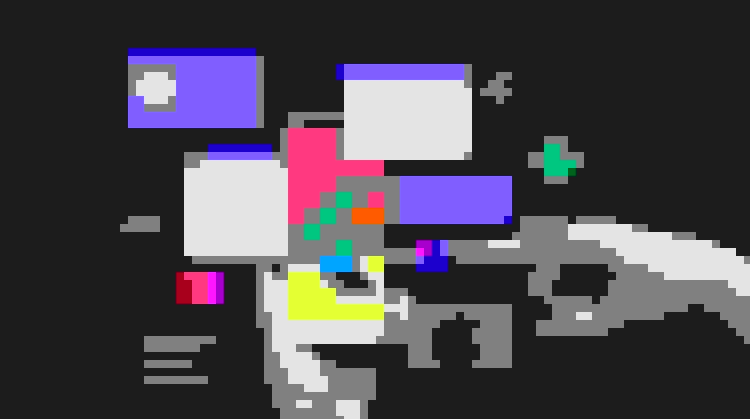Table of contents
What is Flutter?
Market Analysis
Why Should You Choose Flutter?
What is the Average Flutter App Development Cost?
How to Reduce and Optimize Your Flutter App Development Budget?
Real-World Examples of Flutter Apps
FAQs About Costs of Flutter App Development
Choosing the right technology stack is crucial for creating a successful dynamic app development application. One such technology that has gained immense popularity is Flutter, an open-source UI software development kit by Google.
In 2018, Google announced a cross-platform framework widely known as Flutter. It has quickly become a familiar term in the app development community, and not without cause. The framework is a flexible tool that enables developers to construct swift, visually appealing mobile apps for Android and iOS. It is cross-platform.
But there's more! Initially, Flutter's capabilities were confined to mobile app development. However, given the reviews, its reach has widened to cover desktop and online app development, which is unsurprising. So, if you're seeking the ideal framework, why not explore Flutter's development possibilities?
This blog will guide you through the essentials of building a Flutter app, focusing on the costs, benefits, and overall development process. Understanding these aspects is vital for anyone looking to leverage Flutter for their app development needs, ensuring an informed decision-making process that can lead to a successful project.
What is Flutter?
Flutter is a comprehensive open-source UI toolkit that enables developers to create natively compiled mobile, web, and desktop applications from a single codebase. Launched by Google, Flutter uses the Dart programming language and provides a rich set of pre-designed widgets, which facilitate the creation of visually appealing and highly interactive applications.
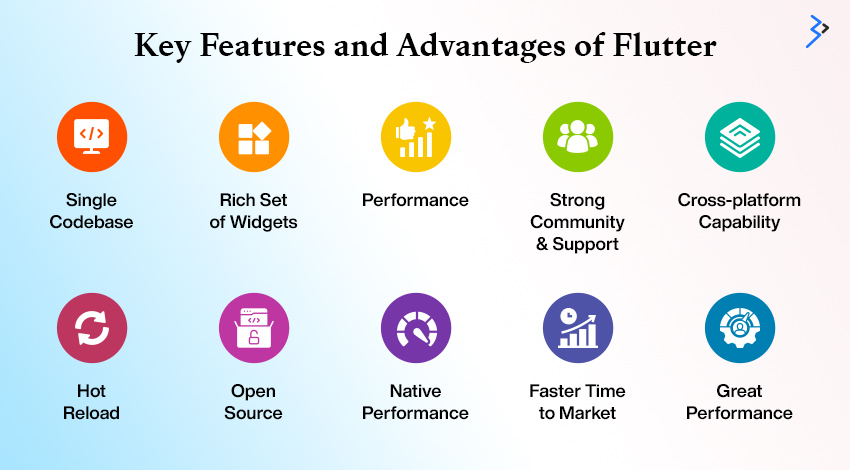
Key Features and Advantages of Flutter
- Single Codebase: Flutter allows developers to write one codebase for multiple platforms, significantly reducing development time and effort.
- Hot Reload: This feature lets developers see changes in real-time, speeding up the development process and making it easier to experiment with UI and fix bugs.
- Rich Set of Widgets: Flutter has a comprehensive library of customizable widgets that adhere to platform-specific design guidelines and offer a native-like experience.
- Performance: With its high-performance rendering engine, Flutter apps achieve near-native performance, providing smooth animations and fast loading times.
- Strong Community and Support: Backed by Google and a growing community, Flutter offers developers a wealth of resources, libraries, and tools.
Market Analysis
Current Market Trends for Flutter App Development
Since its launch, Flutter has seen rapid adoption, with a growing number of developers and businesses choosing it for app development. According to recent statistics, Flutter is one of the most popular frameworks for cross-platform development, alongside React Native and Xamarin.
Market Share
Flutter's market share has been expanding since its inception in 2018, and it is expected to reach 14% by 2024. According to Statista, 39% of developers prefer Flutter to React for mobile app development.
Adaptability
Flutter's versatility, performance, and cross-platform features make it a popular choice for both new and existing enterprises.
Artificial Intelligence
AI-powered tools and methods can assist development teams in coding. Flutter AI is also becoming prominent in the age of generative AI.
IoT
Flutter can let developers create applications that can remotely operate and monitor gadgets, which might revolutionize the electronics sector. Demand for IoT connectivity with Flutter apps is expected to double by 2024.
Comparison with Other Popular Frameworks
Compared to other frameworks like React Native and Xamarin, Flutter stands out for its single codebase approach, extensive widget library, and excellent performance. While React Native also offers cross-platform capabilities, it requires separate files for iOS and Android designs, making Flutter more streamlined. Xamarin, on the other hand, is more suitable for enterprise-level applications with its strong integration with Microsoft’s ecosystem, but it often comes with higher costs.
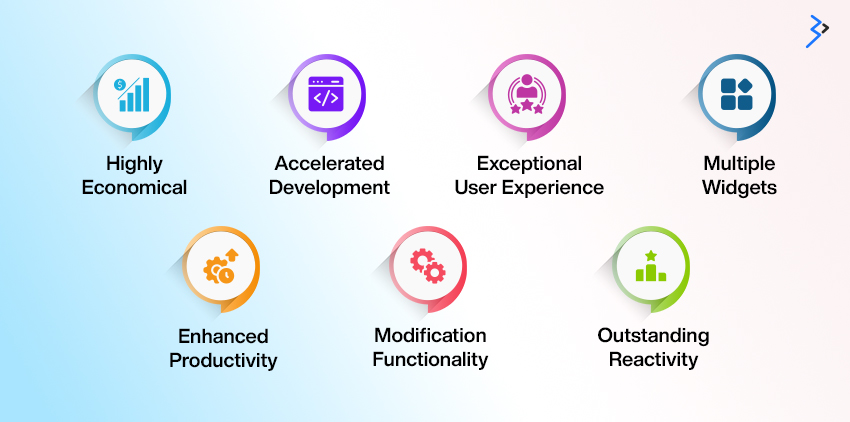
Why Should You Choose Flutter?
Choosing the right framework is critical for the success of an app. Here are some compelling reasons why Flutter might be the right choice for your project:
Highly Economical
One of the most significant advantages of using Flutter is its cost-effectiveness. Flutter reduces the need for separate development teams and overall development time and costs by allowing a single codebase for multiple platforms. This unified approach also simplifies maintenance and updates, further reducing long-term expenses.
Accelerated Development
Flutter’s hot reload feature lets developers see changes instantly, accelerating development. This feature is particularly beneficial during the UI design phase, allowing quick iterations and refinements. The single codebase also means fewer lines of code to write, debug, and maintain, leading to a faster development cycle.
Exceptional User Experience
Flutter is known for its high-quality, visually appealing UI components. It provides a rich set of customizable widgets that enable developers to create unique and engaging user experiences. The framework’s design capabilities ensure that the app’s look and feel are consistent across different platforms, providing a seamless experience for users.
Multiple Widgets
Flutter’s extensive widget library includes various elements like buttons, sliders, and forms that can be customized to fit any app’s theme. These widgets are versatile and highly optimized for performance, ensuring smooth animations and quick loading times.
Enhanced Productivity
With a unified development environment, Flutter enhances productivity by allowing developers to work on Android and iOS simultaneously. The integrated toolset and features like hot reload further boost efficiency, enabling quicker development and deployment cycles.
Modification Functionality
Flutter makes it easy to modify and update apps. Whether you need to add new features, change the UI, or fix bugs, Flutter’s hot reload and modular architecture make these tasks straightforward. This flexibility is particularly valuable for projects that require frequent updates or iterative development.
Outstanding Reactivity
Flutter’s reactive framework allows for highly responsive apps that can easily handle complex interactions and animations. This reactivity and the framework’s performance optimizations ensure that apps run smoothly even on older devices.
What is the Average Flutter App Development Cost?
Understanding the costs associated with Flutter app development is crucial for budgeting and planning your project. The cost can vary significantly based on several factors, including the app’s complexity, features, and the team’s expertise.
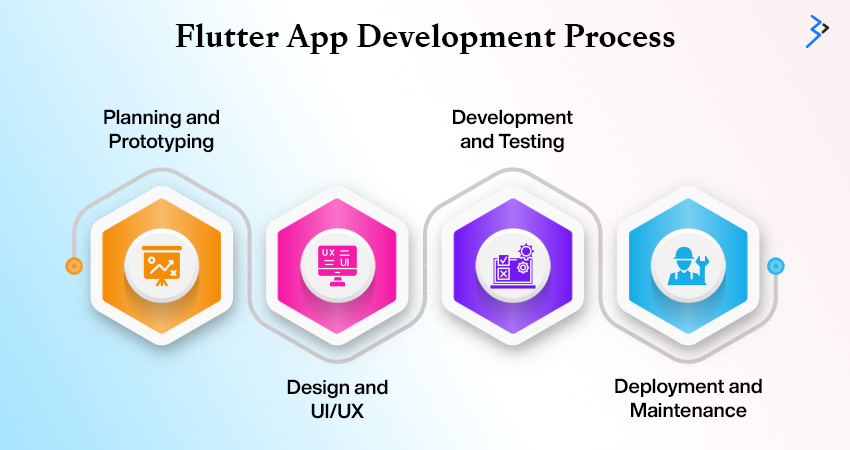
Cost Breakdown by Development Phases
- Planning and Prototyping: This phase involves defining the project’s scope, creating wireframes, and setting up the initial architecture. It typically accounts for 10-15% of the total project cost.
- Design and UI/UX: The design phase includes creating visual elements and user interfaces. Depending on the complexity and uniqueness of the design, this phase can take up 15-20% of the total budget.
- Development and Testing: Most of the budget goes into the development and testing phase, usually around 50-60%. This phase includes writing code, integrating APIs, and rigorous testing to ensure the app’s functionality and stability.
- Deployment and Maintenance: After development, the app must be deployed and maintained in app stores. This phase typically costs 10-15% of the total budget, including server costs, updates, and bug fixes.
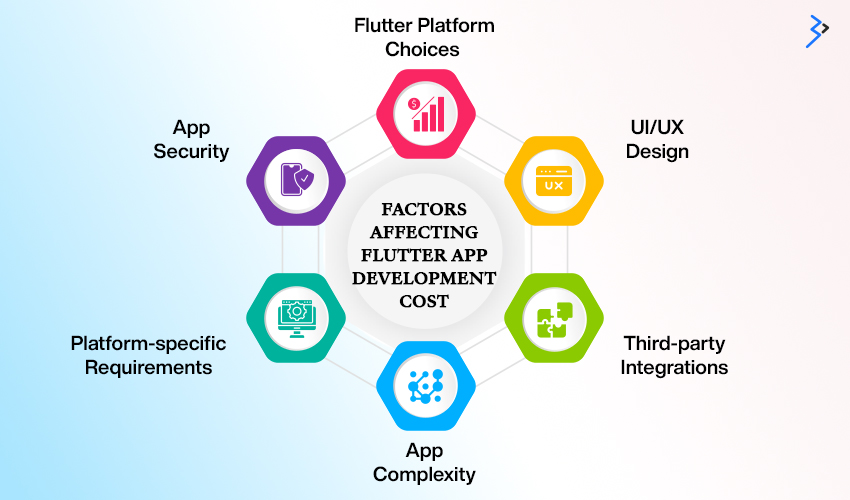
Additional Cost Factors
- Third-party Integrations: Integrating third-party services or APIs, such as payment gateways, social media, or analytics tools, can add to the cost.
- App Complexity: More complex apps with advanced features like real-time updates, AR/VR, or heavy graphics will naturally cost more.
- Platform-specific Requirements: While Flutter allows for cross-platform development, certain features or optimizations specific to iOS or Android may require additional work, which can affect the cost.
How to Reduce and Optimize Your Flutter App Development Budget?
Optimizing the development budget without compromising on quality is essential for any project. Here are some strategies to consider:
Outsource the Task
Outsourcing to experienced Flutter development companies can be a cost-effective solution. Many companies offer competitive rates, especially those based in regions with lower labor costs. Outsourcing also provides access to a broader talent pool, allowing you to find developers with the expertise your project needs.
Employ Freelancers
Hiring freelance developers can be economical for smaller projects or specific tasks within a larger project. Freelancers often offer more flexible pricing models and can be hired on a project or hourly basis, allowing you to control costs more effectively.
Eliminate Any Unnecessary Functions and Features
Focusing on core functionalities and eliminating unnecessary features can significantly reduce development time and costs. Prioritize essential features that provide the most value to your users, and consider adding advanced features in future updates once the app gains traction.
Real-World Examples of Flutter Apps
Here are some real-world examples of successful Flutter apps that have helped many businesses succeed in their field; let us explore and understand why choosing this cross-platform is essential.
1. Google Ads
Google Ads is among the most famous Flutter app examples. It enables you to customize campaigns and advertisements according to your preferences. The Flutter development improved the Google Ads app's reliability and insight. It now provides developers with improved insights, faster campaign notifications, campaign statistics, and the ability to contact a Google expert directly from the app.
2. Stadia
Stadia, Google's game platform, is built on Flutter. It's an easy-to-use program that lets you play your favorite games on your existing displays. The organization used Flutter again throughout the project's prototype stage.
3. Google Pay
Google Pay is one of Google's most reliable and well-known online payment applications. With over 70 million users worldwide, the Google Pay app required a framework that could assist the firm in improving its functionality and environment, and Flutter met the criteria! The new Google Pay app can now easily expand across iOS and Android devices.
4. SpaceX App
Flutter was also used to construct the SpaceX Go, the company's incredibly simple and efficient launcher. The app sought to provide customers with a simple and speedy SpaceX experience, and Flutter was the ideal option!
5. eBay Motors
eBay Motors, eBay's native app, also used the developer-friendly and simple Flutter framework to improve its functionality and attractiveness. Before moving ahead, eBay spent a month identifying gaps in Flutter's potential. However, Flutter performed admirably and efficiently completed the company's responsibilities.
FAQs About Costs of Flutter App Development
1. What is the typical hourly rate for Flutter developers?
The hourly rate for Flutter developers can vary widely based on their experience and location. In the US, rates typically range from $50 to $150 per hour, while in regions like Eastern Europe or Asia, rates can be as low as $20 to $50 per hour.
2. How long does it take to develop a Flutter app?
The development time for a Flutter app depends on its complexity. A simple app can take 2-3 months, while a more complex app with advanced features can take 6-9 months or longer.
3. Can I reduce costs by using Flutter for a minimum viable product (MVP)?
Yes, Flutter is an excellent choice for building an MVP due to its rapid development capabilities. By focusing on core features and leveraging Flutter’s cross-platform nature, you can reduce costs and time to market.
4. Is Flutter good for app development?
Yes, Flutter is an excellent choice for app development. It offers a single codebase for multiple platforms, fast performance, and a variety of customizable UI widgets.
5. What programming language does Flutter use?
Flutter uses the Dart programming language for app development.
6. What is a Flutter app developer?
A Flutter app developer is a professional who specializes in building mobile applications using the Flutter framework.
7. How do you create a Flutter app?
To create a Flutter app, use the Flutter SDK and Dart programming language, leveraging Flutter's vast widgets to build the user interface and integrate desired features.
Final Thoughts
Building a Flutter app involves carefully considering costs, benefits, and the development process. Flutter offers a range of advantages, including cost-effectiveness, accelerated development, and a rich set of widgets, making it an excellent choice for cross-platform app development. Understanding the cost factors and employing strategies to optimize your budget can ensure a successful project. Whether you’re a startup looking to build an MVP or an established company aiming to reach a broader audience, Flutter provides the tools and capabilities to achieve your goals.
Plenty of resources and communities are available online for those interested in exploring Flutter app development further. Engaging with these can provide additional insights and support as you embark on your development journey
Related Articles
Digital Transformation
Hyper-Personalized Banking: Driving Customer Loyalty and Engagement with AI-Powered Adobe Experiences
Digital Transformation
Leveraging 3rd Party LLMs: A Guide to Commercial AI Platforms
Digital Transformation
AI-Driven Security: Protecting Your eCommerce App and Customer Data in an Evolving Threat Landscape
